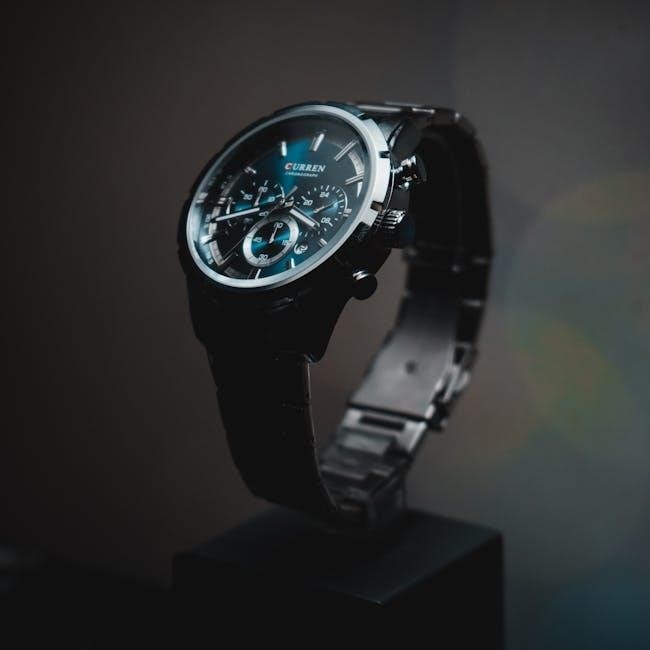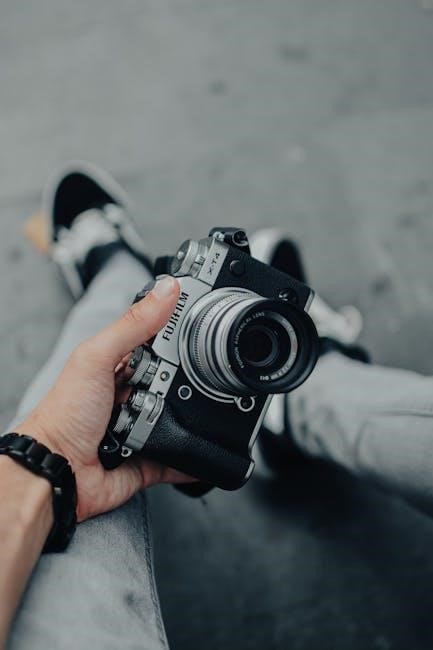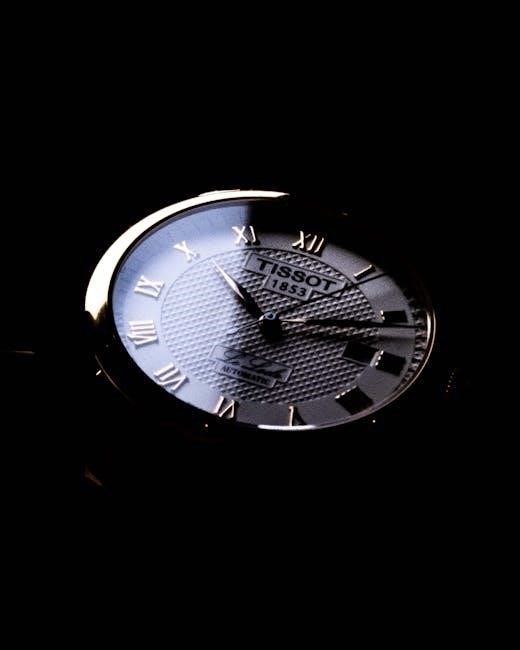
manual vs automatic watch
Manual and automatic watches offer distinct experiences, blending history, craftsmanship, and functionality. While manual watches require daily winding, automatic watches harness motion for self-winding, appealing to different lifestyles and preferences.
1.1 Overview of Manual Watches
A manual watch, also known as a hand-wound watch, requires the wearer to wind it daily by turning the crown. This mechanical process stores energy in the mainspring, powering the watch. Unlike automatic watches, manual watches do not rely on movement to wind, making them more precise and often preferred by collectors. They are celebrated for their craftsmanship and the intimate ritual of winding, offering a tangible connection to horology. Manual watches are typically lighter and thinner, appealing to those who value tradition and the artistry of watchmaking.
1.2 Overview of Automatic Watches
An automatic watch, also known as a self-winding watch, uses the wearer’s movements to wind the mainspring, eliminating the need for daily manual winding. This convenience makes automatic watches ideal for everyday wear. The watch contains a rotor that spins with motion, generating power and storing it in the mainspring. Automatic watches are praised for their practicality and engineering marvel, appealing to those who value ease of use without compromising on craftsmanship. They are a popular choice for individuals seeking a timepiece that combines functionality with aesthetic appeal, making them a staple in modern horology.
1.3 Historical Context of Watchmaking
Watchmaking has a rich history rooted in precision and innovation. The evolution from manual to automatic watches reflects advancements in horology. Manual watches, the earliest type, required daily winding, while automatic watches emerged later, leveraging motion to wind the mainspring. This innovation, introduced in the 20th century, revolutionized timekeeping by offering convenience without sacrificing craftsmanship. The historical journey of watchmaking highlights human ingenuity and the pursuit of perfection, making mechanical watches timeless pieces that connect wearers to centuries of tradition and engineering excellence.
Defining Manual and Automatic Watches
Manual and automatic watches are both mechanical timepieces, but they differ in their winding mechanisms. Manual watches require daily winding by the user, while automatic watches wind themselves through movement.
2.1 What is a Manual Watch?
A manual watch, also known as a hand-wound watch, is a mechanical timepiece that requires the user to wind it daily by turning the crown. This action stores energy in the mainspring, which powers the watch’s movement. Unlike automatic watches, manual watches do not have a self-winding mechanism, relying solely on the wearer’s intervention. The process of winding a manual watch is often seen as a deliberate and intimate ritual, appealing to those who appreciate the tactile connection to their timepiece. Manual watches are celebrated for their simplicity, craftsmanship, and the direct interaction they demand from the wearer.
2.2 What is an Automatic Watch?
An automatic watch is a self-winding mechanical timepiece that harnesses the wearer’s movements to generate power. Inside the watch, a rotor oscillates with the wearer’s motion, winding the mainspring and storing energy. This eliminates the need for daily manual winding, offering greater convenience. Automatic watches are ideal for everyday wear, as they maintain accuracy and functionality with minimal user intervention. Their design combines practicality with engineering excellence, making them a popular choice for those who value both style and ease of use in their timekeeping companion.
2.3 Clarifying the Difference Between Mechanical and Automatic Watches
A mechanical watch is powered by a mainspring, which stores energy when wound. This can be done manually or through an automatic mechanism. An automatic watch, therefore, is a type of mechanical watch that uses a self-winding rotor to generate power from the wearer’s movements. While all automatic watches are mechanical, not all mechanical watches are automatic. This distinction is often misunderstood, but it lies in the winding mechanism. Automatic watches offer the convenience of self-winding, while manual mechanical watches require deliberate winding by the user.

History and Evolution
Manual watches trace their origins to early horology, while automatic watches emerged later, revolutionizing convenience. Both reflect the evolution of watchmaking, blending tradition with innovation.
3.1 The Origins of Manual Watches
Manual watches, also known as hand-wound watches, trace their origins to the early days of horology in the 16th century. These timepieces were the first to utilize mechanical movements, relying on a mainspring that required daily winding by the wearer. The invention of the mainspring by Peter Henlein marked a pivotal moment, enabling portable timekeeping devices. Over time, manual watches evolved, with improvements in accuracy and design. They became symbols of craftsmanship, with their intricate mechanisms visible through transparent casework. The ritual of winding a manual watch remains a cherished tradition, connecting wearers to the rich history of watchmaking.
3.2 The Development of Automatic Watches
Automatic watches, also known as self-winding watches, emerged in the 18th century with Abraham-Louis Perrelet’s invention of the first self-winding mechanism. However, it wasn’t until the 20th century that automatic watches gained popularity. In 1923, John Harwood developed the first practical automatic wristwatch, and Rolex later introduced the Perpetual Rotor in 1931, enabling bidirectional winding. This innovation made automatic watches more reliable and convenient. The development of automatic watches revolutionized horology, offering a practical alternative to manual winding while maintaining the elegance and craftsmanship of mechanical timepieces. Their self-sustaining nature has made them a favorite among watch enthusiasts worldwide.
3.3 Key Milestones in Watchmaking Technology
Watchmaking has seen remarkable advancements, with milestones shaping the industry. The invention of the mainspring in the 15th century enabled portable timepieces. In 1801, Breguet introduced the tourbillon, countering gravity’s effects on accuracy. The 20th century brought the quartz movement, though mechanical watches remained cherished. Rolex’s 1931 Perpetual Rotor revolutionized automatic watches, while modern innovations like silicon components and ultra-thin movements continue to push boundaries. These milestones reflect horology’s blend of artistry and engineering, driving the evolution of both manual and automatic watches into timeless pieces celebrated for their craftsmanship and precision.
Comparison of Features
Manual watches require daily winding, offering a personal connection, while automatic watches are self-winding, providing convenience. Differences include power reserve, maintenance needs, accuracy, size, weight, and cost considerations.
4.1 Winding Mechanisms: Manual vs. Automatic
A manual watch requires the wearer to wind it daily by turning the crown, a deliberate and personal ritual. This direct interaction ensures the watch is powered and accurate. In contrast, an automatic watch uses a self-winding mechanism, where the rotor inside the movement captures kinetic energy from the wearer’s movements, eliminating the need for manual winding. This convenience makes automatic watches ideal for everyday use, while manual watches appeal to those who appreciate the tactile experience and connection to horological tradition.
4.2 Power Reserve: Manual vs. Automatic Watches
A manual watch typically has a shorter power reserve, lasting 1-3 days, as it relies on manual winding. This requires the wearer to wind it daily to maintain accuracy. In contrast, automatic watches often have a longer power reserve, usually between 38-48 hours, but some high-end models can last up to 7 days or more. The power reserve depends on the movement’s efficiency and the wearer’s activity level for automatic watches. Manual watches, however, consistently require winding, making them less convenient for extended periods without use.
4.3 Maintenance and Upkeep Requirements
Both manual and automatic watches require regular maintenance to ensure optimal performance. Manual watches need consistent winding to maintain power reserve, while automatic watches rely on wearer activity to stay powered. Both types typically require servicing every 4-6 years to clean and lubricate internal components. Automatic watches may need additional adjustments to their self-winding mechanisms. Proper care, such as avoiding extreme temperatures and magnetic fields, is essential for both. Manual watches benefit from daily winding to prevent stagnation, while automatics thrive with regular wear. Neglecting maintenance can lead to accuracy issues and mechanical damage over time.
4.4 Accuracy and Timekeeping
Manual and automatic watches differ slightly in accuracy and timekeeping. Manual watches can be more precise if wound consistently, as they avoid the variability introduced by automatic winding. However, automatic watches maintain consistent power delivery, which can enhance accuracy over time. Both types are susceptible to factors like temperature and position, which can affect their timekeeping. High-quality movements in either type can achieve chronometer certification, ensuring high accuracy. Regular servicing is crucial for both to maintain optimal performance and precision, making them reliable choices for everyday wear.
4.5 Size and Weight Differences
Manual and automatic watches often differ in size and weight due to their mechanisms. Manual watches are typically thinner and lighter since they lack the automatic winding rotor, making them more comfortable for smaller wrists. Automatic watches, while slightly thicker and heavier, offer a more robust feel that some users prefer. The added weight of automatic watches can also provide a sense of luxury and durability. These physical differences play a role in personal preference, with manual watches appealing to those who value sleekness and automatic watches suiting those who enjoy a more substantial timepiece.
4.6 Cost and Value Considerations
Manual and automatic watches vary in cost and value, influenced by their mechanisms and craftsmanship. Manual watches are often more affordable due to their simpler design, while automatic watches tend to be pricier because of the self-winding feature. High-end manual watches, however, can rival automatics in price due to intricate details. Automatic watches may offer better long-term value for everyday wear, as they require less maintenance. Ultimately, the choice depends on budget, lifestyle, and appreciation for horology, with both types offering unique value propositions for collectors and enthusiasts alike.

Lifestyle Considerations
Manual watches appeal to those who enjoy the ritual of winding, while automatic watches offer convenience for daily wear, catering to different lifestyles and preferences seamlessly.
5.1 Daily Wear and Convenience
Automatic watches excel in daily wear due to their self-winding mechanism, eliminating the need for manual winding. This makes them ideal for busy individuals who value convenience. Manual watches, while less convenient, offer a unique tactile experience through daily winding, appealing to those who cherish tradition and personal interaction with their timepiece. The choice between the two ultimately depends on lifestyle preferences, with automatic watches catering to ease and manual watches satisfying enthusiasts who enjoy the ritual of winding.
5.2 Travel and Time Zone Adjustments
Traveling across time zones can influence the choice between manual and automatic watches. Automatic watches are more convenient for frequent travelers, as they maintain accuracy without manual intervention. However, their slightly heavier weight due to the rotor may be a consideration. Manual watches, while requiring daily winding, offer precise control during time adjustments, which can be beneficial when setting the time in different zones. The decision hinges on whether the traveler prioritizes low-maintenance convenience or the tactile experience of manual adjustments, weighing factors like ease of use and personal preference during journeys.
5.3 Formal Events and Aesthetic Appeal
Manual and automatic watches both excel in formal settings, but their aesthetic appeal varies. Manual watches are often slimmer, making them ideal for formal wear, while their intricate movements are visible through exhibition casebacks, adding sophistication. Automatic watches, though slightly thicker due to the rotor, still offer sleek designs and a touch of engineering marvel. For formal events, the choice often comes down to personal style and the desire for visible craftsmanship. Manual watches evoke a sense of tradition and craftsmanship, while automatic watches blend elegance with practicality, making both suitable for high-end occasions.

Design and Aesthetics
Manual watches often feature slimmer designs and visible movements, appealing to those who appreciate craftsmanship. Automatic watches, while slightly thicker, offer sleek aesthetics and engineering marvels, blending form and function.

6.1 Movement Visibility in Manual Watches
Manual watches often showcase their intricate mechanical movements through transparent case backs, offering a glimpse into the craftsmanship. This feature is cherished by horology enthusiasts, as it highlights the artistry and precision engineering behind each timepiece. The visible gears and springs create a sense of connection to the watch’s inner workings, making it a desirable choice for collectors and those who appreciate the beauty of mechanical watchmaking. This transparency not only adds aesthetic value but also serves as a testament to the watchmaker’s skill and attention to detail.
6.2 Aesthetic Appeal of Automatic Watches
Automatic watches are celebrated for their sleek designs and versatility, appealing to both formal and casual settings. Their self-winding mechanism eliminates the need for daily winding, making them a practical yet stylish choice. The smooth, uninterrupted operation of automatic watches is often admired, and their ability to adapt to various lifestyles enhances their allure. Many automatic watches feature intricate details and finishes, showcasing the craftsmanship behind their creation. Whether dressed up or down, automatic watches exude timeless elegance, making them a favorite among watch enthusiasts who value both functionality and aesthetic sophistication.
6.3 Customization and Personalization Options
Both manual and automatic watches offer opportunities for customization, allowing owners to tailor their timepieces to personal preferences. Manual watches often feature visible mechanical components, enabling unique engravings or decorative finishes. Automatic watches, with their self-winding mechanisms, may offer customizable rotors or oscillating weights. Many brands provide bespoke services, such as interchangeable straps, dial color options, or special edition designs. These personalization options allow wearers to express individuality, making each watch a reflection of their style and identity. Whether through subtle details or bold designs, customization enhances the emotional connection to the watch.
Emotional and Cultural Significance
Manual watches evoke a tactile connection through daily winding, while automatic watches symbolize engineering prowess. Both embody craftsmanship, heritage, and personal stories, transcending timekeeping into emotional heirlooms.
7.1 The Ritual of Winding a Manual Watch
Winding a manual watch is a deliberate, tactile ritual that fosters a deep connection to the timepiece. Each turn of the crown engages the wearer with the watch’s inner mechanics, creating a sense of ownership and appreciation for craftsmanship. This daily interaction becomes a meditative moment, emphasizing the value of slowing down in a fast-paced world. For many, the act of winding is a satisfying reminder of the watch’s reliance on human touch, blending tradition with personal engagement in a way that transcends mere timekeeping.
7.2 The Engineering Marvel of Automatic Watches
Automatic watches are celebrated as engineering marvels, combining innovation and precision. Their self-winding mechanism captures kinetic energy from the wearer’s movements, eliminating the need for manual winding. This intricate system, often visible through transparent casebacks, showcases the artistry of horology. The automatic watch’s ability to blend functionality with elegance makes it a testament to human ingenuity, appealing to those who appreciate both convenience and craftsmanship. Its design reflects a harmonious balance between technical complexity and aesthetic appeal, making it a cherished possession for watch enthusiasts worldwide.
7.3 Collectibility and Legacy
Both manual and automatic watches hold significant collectibility and legacy value, cherished by horology enthusiasts. Manual watches are often sought for their historical craftsmanship and the intimate ritual of winding, evoking a connection to watchmaking’s past. Automatic watches, with their self-winding innovation, are admired for their engineering brilliance and practicality. Iconic models from renowned brands become heirlooms, passed down through generations. Collectors prize these timepieces for their artistic and technical merits, as well as their ability to transcend time, embodying a lasting legacy in the world of horology.

Common Misconceptions
Many believe automatic watches are superior to manual ones, but both have unique merits. Misconceptions often arise from confusing mechanical and automatic terms or overlooking maintenance needs.
8.1 Debunking Myths About Manual Watches
One common myth is that manual watches are inconvenient due to daily winding. However, many find the ritual enjoyable and meaningful. Another misconception is that manual watches are less accurate than automatic ones, but this is untrue if properly maintained. Some believe manual watches are outdated, yet they remain popular for their craftsmanship and emotional appeal. While they may not suit everyone, manual watches offer a unique connection to horological tradition, making them a cherished choice for enthusiasts who appreciate their mechanical beauty and historical significance.
8.2 Clarifying Misconceptions About Automatic Watches
A common misconception is that automatic watches are maintenance-free, but they still require periodic servicing. Some believe they are thicker due to the rotor, yet modern designs often rival manual watches in slimness. Another myth is that automatic watches only suit active individuals, though moderate movement suffices for most. While they are more convenient, they are not inherently more accurate than manual watches. Understanding these nuances helps appreciate the engineering and practicality automatic watches offer, making them a versatile choice for everyday wear and horological enthusiasts alike.

Expert Opinions and User Testimonials
Horologists and enthusiasts praise manual watches for their tactile winding ritual, while automatic watches are lauded for their convenience and self-winding innovation, each appealing to different passions.
9.1 Horologists’ Perspectives on Manual Watches
Horologists often highlight the craftsmanship and historical significance of manual watches, emphasizing the tactile experience of winding. They appreciate the mechanical complexity and the direct connection to watchmaking traditions.

Manual watches are seen as a testament to precision engineering, offering a unique bond between the wearer and the timepiece. Many horologists view them as a purist’s choice, celebrating the artistry and heritage of mechanical watchmaking.
9.2 Watch Enthusiasts’ Experiences with Automatic Watches
Watch enthusiasts often praise automatic watches for their convenience and self-winding functionality, making them ideal for daily wear. Many appreciate the seamless experience of not needing to wind the watch manually.

Enthusiasts also highlight the engineering marvel behind automatic movements, admiring the intricate mechanics that harness kinetic energy. The smooth, effortless operation and the satisfaction of the watch winding itself resonate deeply with collectors and everyday wearers alike.

Conclusion and Final Thoughts
Manual and automatic watches each offer unique charm, balancing tradition and convenience. The choice ultimately depends on personal preference, lifestyle, and the desired connection to horological craftsmanship.
10.1 Summarizing the Key Differences
Manual watches require daily winding, offering a tactile connection to horology, while automatic watches self-wind through motion, providing convenience. Manual watches often have longer power reserves but demand consistent upkeep. Automatics are ideal for everyday wear due to their ease of use. Accuracy varies slightly, with manuals typically being more precise. Size and weight differences are minimal, though automatics may be thicker due to the rotor. Cost considerations show manuals can be more affordable, while automatics often carry a premium. Ultimately, the choice hinges on personal preference, lifestyle, and the desired balance between tradition and practicality.
10.2 Making the Right Choice for Your Needs
Choosing between a manual and automatic watch depends on your lifestyle and preferences. If you value tradition and the ritual of winding, a manual watch is ideal. For convenience and everyday wear, an automatic watch is preferable. Consider how often you plan to wear the watch; manuals need daily attention, while automatics are more forgiving. Budget is another factor, as automatics often come at a higher price. Ultimately, the decision should align with how you interact with your timepiece and the balance between craftsmanship and practicality that suits your daily life and personal style.
Further Reading and Resources
Explore in-depth guides, articles, and books on manual and automatic watches. Discover expert recommendations and resources to enhance your understanding of horology and timepiece craftsmanship.
11.1 Recommended Articles and Guides
For a deeper understanding, explore articles like “Mechanical vs. Automatic Watches” by Teddy Baldassarre, which compares winding mechanisms and lifestyle suitability. Watchfinder’s guide offers insights into maintenance and accuracy, while The Watch Guide provides a detailed comparison of manual and automatic movements. These resources, along with expert blogs from horology enthusiasts, will help you make informed decisions. Additionally, consider books like “The Watch Book” by Gisbert Brunner for a comprehensive overview of watchmaking history and technology.
11.2 Suggested Books on Watchmaking
For in-depth knowledge, consider “The Watch Book” by Gisbert Brunner, which explores the history and mechanics of timepieces. “Watches: A Guide to Watches” by Gene Stone offers a comprehensive overview of manual and automatic watches. “Horology: A Comprehensive Guide” by Eric Silver provides detailed insights into watch movements and craftsmanship. These books, along with “The Art of Watchmaking” by George Daniels, are essential reads for enthusiasts seeking to understand the nuances of manual and automatic watches, their history, and their cultural significance.